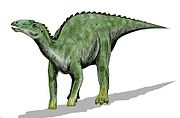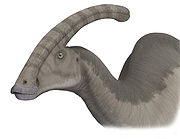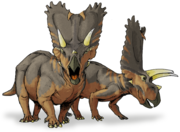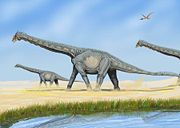
Kirtland Formation
Encyclopedia
The Kirtland Formation is a sedimentary
geological formation. It is the product of alluvial muds and overbank
sand deposits from the many channels draining the coastal plain that existed on the inland seashore of North America
, in the late Cretaceous
period. It overlies the Fruitland Formation
. It is found in the San Juan Basin
in the states of New Mexico
and Colorado
, in the United States of America.
Sedimentary rock
Sedimentary rock are types of rock that are formed by the deposition of material at the Earth's surface and within bodies of water. Sedimentation is the collective name for processes that cause mineral and/or organic particles to settle and accumulate or minerals to precipitate from a solution....
geological formation. It is the product of alluvial muds and overbank
Overbank
The term overbank describes the type of alluvial geological deposit or sediment that is deposited on the flood plain of a river. Because it occurs outside the main channel, away from faster flow, the deposit tends to be fine-grained....
sand deposits from the many channels draining the coastal plain that existed on the inland seashore of North America
North America
North America is a continent wholly within the Northern Hemisphere and almost wholly within the Western Hemisphere. It is also considered a northern subcontinent of the Americas...
, in the late Cretaceous
Cretaceous
The Cretaceous , derived from the Latin "creta" , usually abbreviated K for its German translation Kreide , is a geologic period and system from circa to million years ago. In the geologic timescale, the Cretaceous follows the Jurassic period and is followed by the Paleogene period of the...
period. It overlies the Fruitland Formation
Fruitland Formation
The Fruitland Formation is a sedimentary geological formation containing layers of sandstone, shale, and coal. It was laid down in marshy delta conditions, with poor drainage and frequent flooding, under a warm, humid and seasonal climate...
. It is found in the San Juan Basin
San Juan Basin
The San Juan Basin is a geologic structural basin in the Four Corners region of the Southwestern United States; its main portion covers around , encompassing much of northwestern New Mexico, southwest Colorado, and parts of Arizona and Utah....
in the states of New Mexico
New Mexico
New Mexico is a state located in the southwest and western regions of the United States. New Mexico is also usually considered one of the Mountain States. With a population density of 16 per square mile, New Mexico is the sixth-most sparsely inhabited U.S...
and Colorado
Colorado
Colorado is a U.S. state that encompasses much of the Rocky Mountains as well as the northeastern portion of the Colorado Plateau and the western edge of the Great Plains...
, in the United States of America.
Bony fish
| Bony fishes of the Kirtland Formation | ||||||
|---|---|---|---|---|---|---|
| Genus | Species | Location | Member | Abundance | Notes | |
Melvius |
M. chauliodous |
|
Member of the Willow Wash local fauna. |
|||
Cartilaginous fish
| Cartilaginous fishes of the Kirtland Formation | ||||||
|---|---|---|---|---|---|---|
| Genus | Species | Location | Member | Abundance | Notes | |
Myledaphus |
M. bipartitus |
|
Member of the Willow Wash local fauna. |
|||
Crurotarsans
| Crurotarsans of the Kirtland Formation | ||||||
|---|---|---|---|---|---|---|
| Genus | Species | Location | Member | Abundance | Notes | |
Brachychampsa Brachychampsa Brachychampsa is an extinct genus of alligatoroid. Specimens have been found from New Mexico, Colorado, Wyoming, Montana, North and South Dakota, New Jersey, and Saskatchewan. One specimen has been found from the Darbasa Formation of Kazakhstan, although the species status is indeterminant for the... |
B. montana |
|
Member of the Willow Wash local fauna. |
|||
Denazinosuchus Denazinosuchus Denazinosuchus is a genus of goniopholidid mesoeucrocodylian. Its fossils have been recovered from the Upper Cretaceous Fruitland Formation and Kirtland Formation of the San Juan Basin, New Mexico... |
D. kirtlandicus |
|
Member of the Willow Wash local fauna. |
|||
Leidyosuchus Leidyosuchus Leidyosuchus is an extinct genus of alligatoroid from the Late Cretaceous of Alberta. It was named in 1907 by Lawrence Lambe, and the type species is L. canadensis. It is known from a number of specimens from the middle Campanian age Dinosaur Park Formation... |
Indeterminate |
|
Member of the Willow Wash local fauna. |
|||
Ornithischians
| Ornithischians reported from the Kirtland Formation | ||||||
|---|---|---|---|---|---|---|
| Genus | Species | Location | Member | Material | Notes | Images |
Ahshislepelta Ahshislepelta Ahshislepelta is a genus of herbivorousankylosaurine ankylosaurid dinosaur from Late Cretaceous deposits of San Juan Basin, New Mexico.... |
A. minor |
|
Incomplete postcranial skeleton |
   |
||
Anasazisaurus Anasazisaurus Anasazisaurus is a genus of hadrosaurid ornithopod dinosaur that lived about 74 million years ago, in the Late Cretaceous Period. It was found in the Farmington Member of the Kirtland Formation, in the San Juan Basin of New Mexico, United States. Only a partial skull has been found to date... |
A. horneri |
"Partial skull." |
||||
Edmontonia Edmontonia Edmontonia was an armoured dinosaur, a part of the nodosaur family from the Late Cretaceous Period. It is named after the Edmonton Formation , the unit of rock it was found in.-Description:... |
E. australis |
Dubious species which is a junior synonym of Glyptodontopelta Glyptodontopelta Glyptodontopelta is a genus of dinosaur from the Late Cretaceous. It was an ankylosaur, an armored dinosaur.... . |
||||
Glyptodontopelta Glyptodontopelta Glyptodontopelta is a genus of dinosaur from the Late Cretaceous. It was an ankylosaur, an armored dinosaur.... |
G. mimus |
|||||
Kritosaurus Kritosaurus Kritosaurus is an incompletely known but historically important genus of hadrosaurid dinosaur. It lived about 73 million years ago, in the Late Cretaceous of North America... |
K. navajovius |
|
Member of the Willow Wash local fauna. |
|||
Naashoibitosaurus Naashoibitosaurus Naashoibitosaurus is a genus of hadrosaurid dinosaur that lived about 73 million years ago, in the Late Cretaceous, and was found in the Kirtland Formation of the San Juan Basin in New Mexico, United States. Only a partial skeleton has been found to date... |
N.ostromi |
|
"Partial skull." |
Member of the Willow Wash local fauna. |
||
Nodocephalosaurus Nodocephalosaurus Nodocephalosaurus is a genus of herbivorous ankylosaurine ankylosaurid dinosaur from Upper Cretaceous deposits of San Juan Basin, New Mexico. The holotype was recovered from the Late Campanian De-na-zin Member of the Kirtland Formation and consists of an incomplete skull... |
N. kirtlandensis |
|
"Partial skull." |
Member of the Willow Wash local fauna. |
||
Parasaurolophus Parasaurolophus Parasaurolophus is a genus of ornithopod dinosaur that lived in what is now North America during the Late Cretaceous Period, about 76.5–73 million years ago. It was an herbivore that walked both as a biped and a quadruped. Three species are recognized: P. walkeri , P. tubicen, and the... |
P. tubicen |
|
"Disarticulated, associated skull and postcraniua, pertaining to at least [three] individuals." |
Member of the Willow Wash local fauna. |
||
Pentaceratops Pentaceratops Pentaceratops is a genus of ceratopsid dinosaur from the late Cretaceous Period of what is now North America. The appearance of Pentaceratops sternbergii in the fossil record marks the end of the Judithian land vertebrate age and the start of the Kirtlandian... |
P. fenestratus |
|||||
P. sternbergi |
|
More common in the lower part of the formation. |
Member of the Willow Wash local fauna. |
|||
Prenocephale Prenocephale Prenocephale was a small pachycephalosaurid dinosaur genus from the Late Cretaceous and was similar in many ways to its close relative, Homalocephale, which may simply represent Prenocephale juveniles. Adult Prenocephale probably weighed around and measured around long... |
P. goodwini |
|
Member of the Willow Wash local fauna. |
|||
Stegoceras Stegoceras Stegoceras is a genus of plant-eating pachycephalosaurid dinosaur that lived in what is now North America during the Late Cretaceous period.... |
S. novomexicanum |
|
"SMP VP-2790, incomplete parietal" |
Also found in the upper Fruitland Formation Fruitland Formation The Fruitland Formation is a sedimentary geological formation containing layers of sandstone, shale, and coal. It was laid down in marshy delta conditions, with poor drainage and frequent flooding, under a warm, humid and seasonal climate... . |
||
Torosaurus Torosaurus Torosaurus is a genus of ceratopsid dinosaur that lived during the late Cretaceous period , between 70 and 65 million years ago. It possessed one of the largest skulls of any known land animal. The frilled skull reached in length... |
T. latus |
Remains tentatively referred to Torosaurus latus include some formerly referred to T. utahensis. |
||||
T. utahensis |
Kirtland remains once attributed to T. utahensis have since been tentatively referred to T. latus. |
|||||
Pterosaurs
| Pterosaur Pterosaur Pterosaurs were flying reptiles of the clade or order Pterosauria. They existed from the late Triassic to the end of the Cretaceous Period . Pterosaurs are the earliest vertebrates known to have evolved powered flight... s of the Kirtland Formation |
||||||
|---|---|---|---|---|---|---|
| Genus | Species | Location | Member | Abundance | Notes | |
Navajodactylus Navajodactylus Navajodactylus is an extinct genus of pterosaur from Late Cretaceous deposits of San Juan Basin, New Mexico and Alberta, Canada.... |
N. boerei |
Partial phalanx and ulna fragment |
Hunter Wash Member |
|||
Saurischians
| Saurischians of the Kirtland Formation | ||||||
|---|---|---|---|---|---|---|
| Genus | Species | Location | Member | Abundance | Notes | Images |
Alamosaurus Alamosaurus Alamosaurus is a genus of titanosaurian sauropod dinosaur from the Late Cretaceous Period of what is now North America. It was a large quadrupedal herbivore. Isolated vertebrae and limb bones indicate that it reached sizes comparable to Argentinosaurus and Puertasaurus, which would make it the... |
A. sanjuanensis |
|
Member of the Willow Wash local fauna. |
 |
||
Albertosaurus Albertosaurus Albertosaurus is a genus of tyrannosaurid theropod dinosaur that lived in western North America during the Late Cretaceous Period, more than 70 million years ago. The type species, A. sarcophagus, was apparently restricted in range to the modern-day Canadian province of Alberta, after which... |
Indeterminate |
|||||
Aublysodon Aublysodon Aublysodon is a name given to a large number of carnivorous dinosaur teeth of a certain form found in numerous late Cretaceous period geological formations... |
A. mirandus |
Remains once attributed to the dubious tooth genus Aublysodon Aublysodon Aublysodon is a name given to a large number of carnivorous dinosaur teeth of a certain form found in numerous late Cretaceous period geological formations... (and later Daspletosaurus Daspletosaurus Daspletosaurus is a genus of tyrannosaurid theropod dinosaur that lived in western North America between 77 and 74 million years ago, during the Late Cretaceous Period. Fossils of the only named species were found in Alberta, although other possible species from Alberta and Montana await... ) are now referred to Bistahieversor Bistahieversor Bistahieversor is a genus of tyrannosauroid dinosaur. Bistahieversor existed around 75 million years ago during the Late Cretaceous.... , although these remains (OMNH 10131) may possibly have come from the Fruitland Formation Fruitland Formation The Fruitland Formation is a sedimentary geological formation containing layers of sandstone, shale, and coal. It was laid down in marshy delta conditions, with poor drainage and frequent flooding, under a warm, humid and seasonal climate... . |
||||
Bistahieversor Bistahieversor Bistahieversor is a genus of tyrannosauroid dinosaur. Bistahieversor existed around 75 million years ago during the Late Cretaceous.... |
B. sealeyi |
|
||||
|
Daspletosaurus Daspletosaurus Daspletosaurus is a genus of tyrannosaurid theropod dinosaur that lived in western North America between 77 and 74 million years ago, during the Late Cretaceous Period. Fossils of the only named species were found in Alberta, although other possible species from Alberta and Montana await... |
Unnamed |
|
Remains formerly referred to an unidentified or undescribed species of Daspletosaurus Daspletosaurus Daspletosaurus is a genus of tyrannosaurid theropod dinosaur that lived in western North America between 77 and 74 million years ago, during the Late Cretaceous Period. Fossils of the only named species were found in Alberta, although other possible species from Alberta and Montana await... were originally attributed to the dubious tooth genus Aublysodon Aublysodon Aublysodon is a name given to a large number of carnivorous dinosaur teeth of a certain form found in numerous late Cretaceous period geological formations... . These remains were later reclassified as belonging to the new genus Bistahieversor Bistahieversor Bistahieversor is a genus of tyrannosauroid dinosaur. Bistahieversor existed around 75 million years ago during the Late Cretaceous.... . Some of these remains (OMNH 10131), however, may have originated in the Fruitland Formation Fruitland Formation The Fruitland Formation is a sedimentary geological formation containing layers of sandstone, shale, and coal. It was laid down in marshy delta conditions, with poor drainage and frequent flooding, under a warm, humid and seasonal climate... . |
|||
Ornithomimus Ornithomimus Ornithomimus is a genus of ornithomimid dinosaur from the Late Cretaceous Period of what is now North America.In 1890 Ornithomimus velox was named by Othniel Charles Marsh on the basis of a foot and partial hand from the Maastrichtian Denver Formation. Another seventeen species have been named since... |
O. antiquus |
|
Member of the Willow Wash local fauna. |
|||
Saurornitholestes Saurornitholestes Saurornitholestes is a genus of carnivorous dromaeosaurid theropod dinosaur from the late Cretaceous of Alberta, Montana and New Mexico.... |
S. langstoni |
|
Specimens once attributed to S. langstoni are now referred to S. robustus. |
|||
S. robustus |
|
Member of the Willow Wash local fauna. |
||||
Struthiomimus Struthiomimus Struthiomimus is a genus of ornithomimid dinosaur from the late Cretaceous of Alberta, Canada. It was a long-legged, ostrich-like dinosaur.The bipedal Struthiomimus stood about long and tall at the hips and weighed around... |
Indeterminate |
|||||
Tyrannosaurus Tyrannosaurus Tyrannosaurus meaning "tyrant," and sauros meaning "lizard") is a genus of coelurosaurian theropod dinosaur. The species Tyrannosaurus rex , commonly abbreviated to T. rex, is a fixture in popular culture. It lived throughout what is now western North America, with a much wider range than other... |
Indeterminate |
|||||
Turtles
| Turtle Turtle Turtles are reptiles of the order Testudines , characterised by a special bony or cartilaginous shell developed from their ribs that acts as a shield... s of the Kirtland Formation |
||||||
|---|---|---|---|---|---|---|
| Genus | Species | Location | Member | Abundance | Notes | |
Basilemys |
B. nobilis |
|
Member of the Willow Wash local fauna. |
|||
Denazinemys |
D. nodosa |
|
Member of the Willow Wash local fauna. |
|||
Neurankylus |
N. baueri |
|
Member of the Willow Wash local fauna. |
|||
Plastomenus |
P. robustus |
|
Member of the Willow Wash local fauna. |
|||
Thescelus |
T. hemispherica |
|
Member of the Willow Wash local fauna. |
|||

